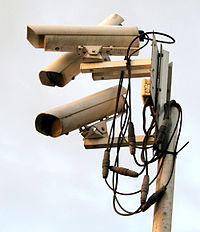Surveillance
Surveillance means watching someone or something.[1][2] It may be secret, and many methods are used including telephone tapping to listen to the person's calls and putting an electronic listening device, a bug, into a room.

Governments and the military have built large facilities designed to listen in to communications between other governments and military groups. For example the U.S. has a large base at Pine Gap near Alice Springs, Australia, which listens to communication signals from all over the world.
Eavesdropping is also surveillance. It means listening to things you aren't supposed to hear. It is a deliberate act, rather than simply overhearing someone else talking.
Surveillance methods
changeMany people engage in surveillance for many purposes.[3] That purpose may be crime prevention, alerting for attacks, or general gathering of information. The results of surveillance are sometimes called "intelligence". Surveillance collects information for police, intelligence agencies, military planners or commercial firms.
This may include observation from a distance by means of electronic equipment (such as CCTV cameras), or interception of electronically transmitted information (such as internet traffic or phone calls). Military surveillance aircraft stay in the air to learn about changes such as traffic on roads or water or air. Nanny cams watch out for the movements of small children. Doorbell cameras watch out for persons approaching a door.
Surveillance may include simple, relatively low-technology methods such as watchtowers, human intelligence agents and postal interception. On the other hand, global surveillance is done by satellite cameras on a daily basis. Such satellites are called "reconnaissance satellite" or spy satellites.
The word surveillance comes from a French phrase for "watching over" ("sur" means "from above" and "veiller" means "to watch").[4][5][6]
Related pages
changeReferences
change- ↑ /sərˈveɪ.əns/ or /sərˈveɪləns/
- ↑ OED
- ↑ Lyon, David. 2007. Surveillance studies: an overview. Cambridge: Polity Press.
- ↑ Minsky M; Kurzweil R . & Mann S. 2013. The society of intelligent veillance, Proceedings of the IEEE. ISTAS. Toronto, Ontario, Canada, pp13-17.[1] Archived 2017-10-19 at the Wayback Machine
- ↑ Clarke R. 1988. Information technology and dataveillance. Communications of the ACM, 31(5), 498-512.
- ↑ Michael K. et al 2010. Planetary-scale RFID services in an age of uberveillance. Proceedings of the IEEE, 98(9), 1663-1671.[2] Archived 2013-12-02 at the Wayback Machine